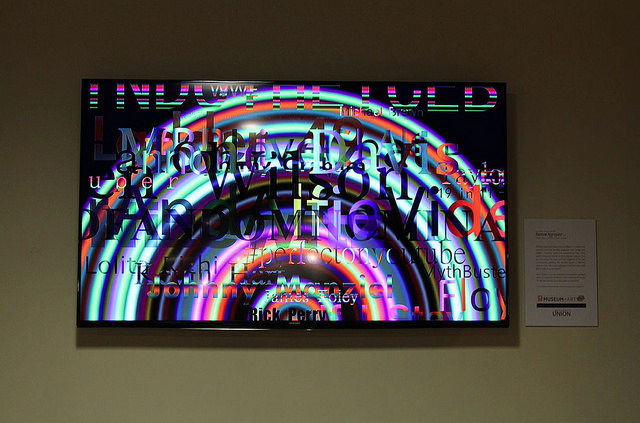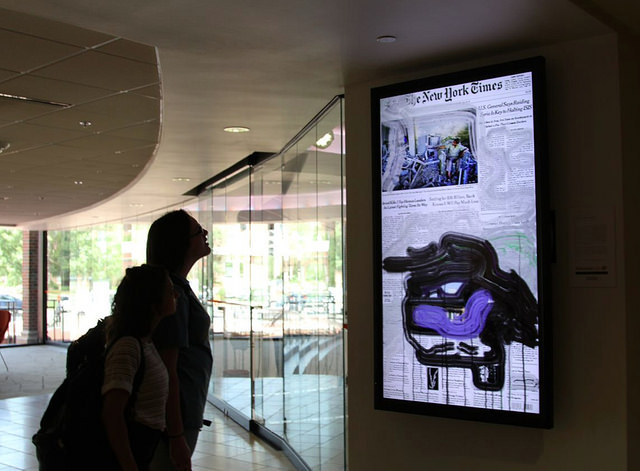Digital art in motion at Oklahoma State University Student Union
Wednesday, October 1, 2014
Two constantly changing digital art pieces are on display on large monitors in the Student Union at Oklahoma State University, thanks to a collaboration between the OSU Museum of Art, the Student Union, and alumni Carl and Marilynn Thoma.
Both dynamic works use a real-time internet connection and current events to create engaging, ever-changing, contemporary art that will be seen by thousands of students each day.
“These are not static artworks that were simply created in the studio and then hung on a wall,” said Jason Foumberg, curator of the Thoma Foundation. “The artworks rely entirely on the invisible labor of the internet, from browsers to bloggers.”

Rainbow Aggregator, 2012
Computer, software, and Internet connection on a monitor.
Carl & Marilynn Thoma Art Foundation
The pieces are on loan from the art collection of Carl and Marilynn Thoma of Chicago, Ill.,1971 graduates of OSU, who said they believe that students are “primed to experience and understand digital art” since they likely share the experience of growing up alongside high technology.
One of the works, “Rainbow Aggregator,” by Jason Salavon, is a continuous, real-time representation of “trending topics” sourced from popular internet sites such as Twitter and Google. Based on current online keyword searches, tags, and posts, Salavon created a software process that translates this stream of data into a pixelated rainbow of constantly shifting words and images. About 30 trends are shown on the screen at a given time, all of which are updated every few minutes as the piece undergoes transitions.
The short and repetitive visual cycle that progresses from a quiet color field to dense data provides commentary on the way information and trends move in and out of our daily consciousness. “Rainbow Aggregator” depicts a collective state of mind - the instant nature of Internet culture that has become familiar to so many. It is featured on the 55-inch monitor near the Student Union food court.
The second art piece, “Daily Times,” by Siebren Versteeg, is a real-time digital program which downloads the front page of The New York Times each morning and produces strokes of color across the page that respond to the particularities of its layout.

Daily Times (performer), 2012
Computer, software, and Internet connection on a monitor.
Carl & Marilynn Thoma Art Foundation
The artist’s algorithmic program for “Daily Times” begins to take action each morning and digital paint builds up and drips down the page as the day passes. At some point in the day, this effect interferes with the viewers’ ability to read the newspaper – transforming the experience from an average glance in the morning to an aesthetic experience in the evening. The resulting abstract image is then discarded, and a new painting begins the next morning, representing the artist’s response to the 24-hour news cycle. “Daily Times” is currently on view on the 70-inch monitor on the Student Union’s second floor near the Campus Life desk.
“Although digital culture is pervasive, digital art is not,” said Foumberg, noting there aren’t many opportunities to see digital art outside of New York City or Europe.
While the Thomas’ are collectors of traditional and contemporary paintings, they don’t ignore other forms of art and seek to expose more viewers to the important art of our time, explained Foumberg. They like the idea of the Student Union being a high-traffic area, because these are high-traffic artworks that depend on continuous internet traffic to be functional.
“We feel everyone could benefit from experiencing this type of artwork, no matter where they live, work, and study,” Foumberg said.
